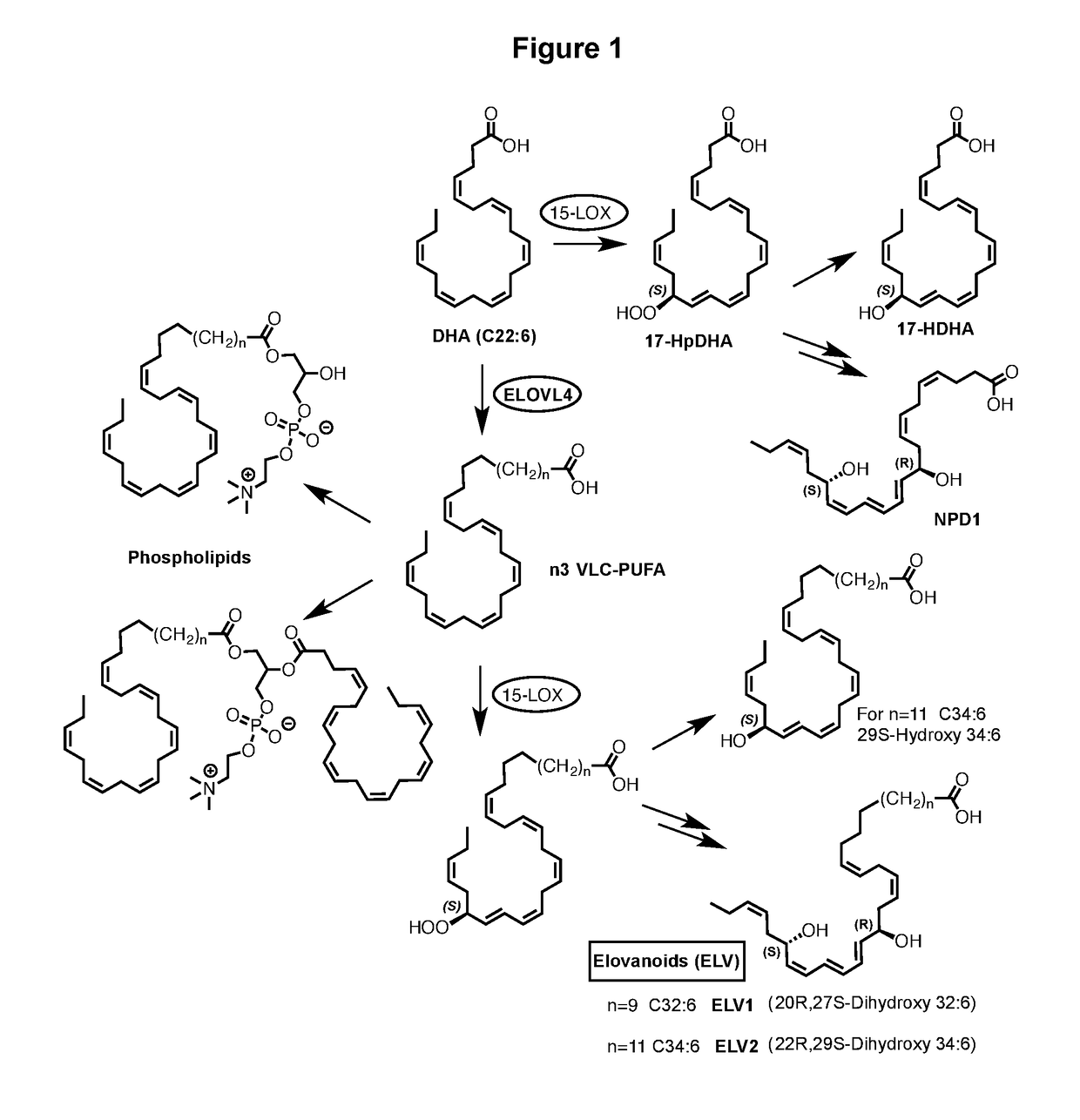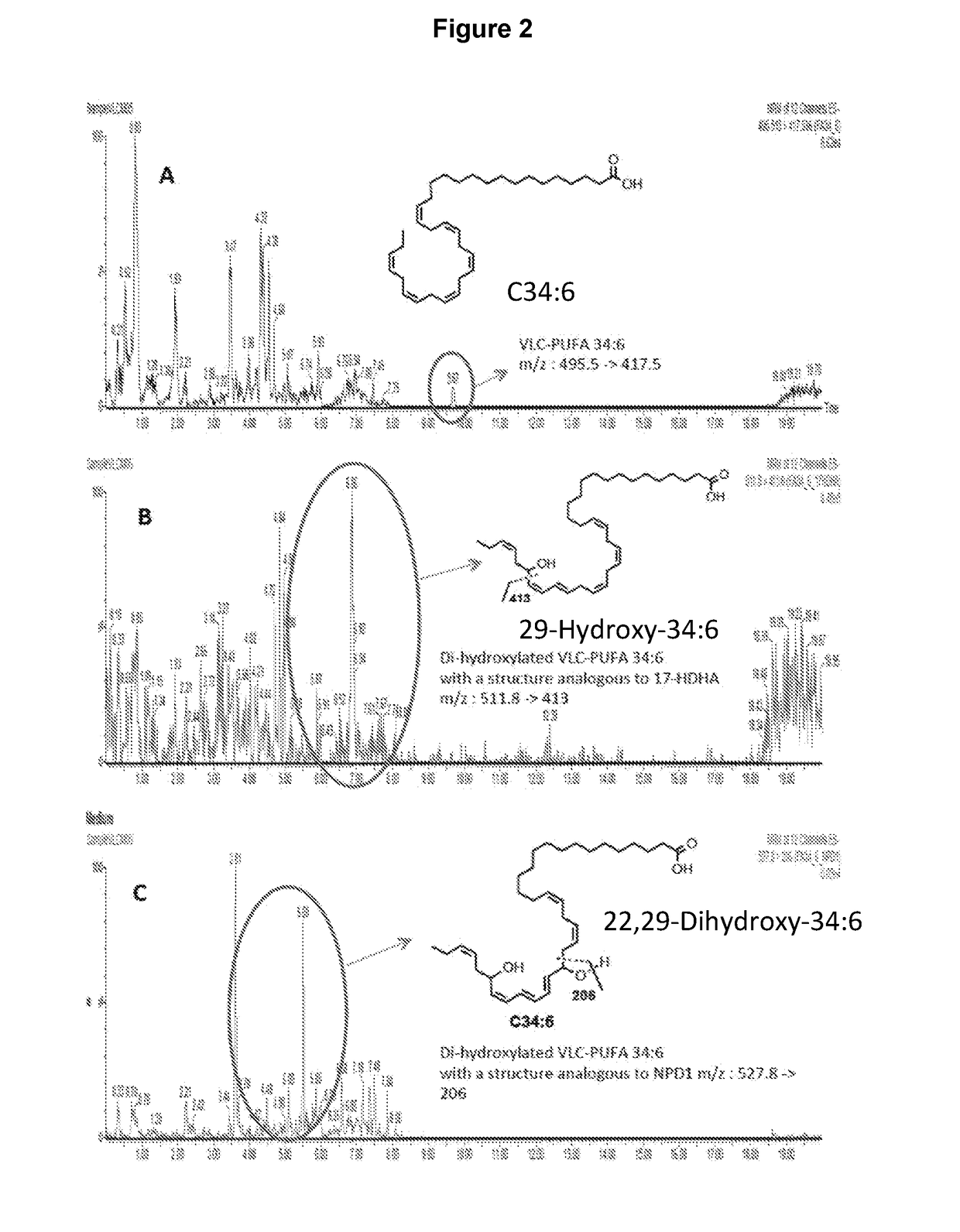Compounds, compositions, and methods for the treatment of inflammatory, degenerative, and neurodegenerative diseases
a neurodegenerative disease and compound technology, applied in the direction of anti-inflammatory agents, group 5/15 element organic compounds, drug compositions, etc., can solve the problems of ineffective treatment of these and other retinal degenerative diseases, inability to slow down the onset of major diseases, and inability to effectively treat these major diseases. , to achieve the effect of improving the stability of the drug, facilitating solubility, bioavailability, and enhancing the chemical and biological stability
- Summary
- Abstract
- Description
- Claims
- Application Information
AI Technical Summary
Benefits of technology
Problems solved by technology
Method used
Image
Examples
example 1
[0189]Evidence for the formation of hydroxylated VLC-PUFA in cells as postulated in FIG. 1, and as documented in FIG. 2. The biogenic conversion of the n3 VLC-PUFA (1) to the mono-hydroxylated derivative 2 and the di-hydroxylated derivative 3 demonstrates the ability of VLC-PUFA to generate hydroxylated derivatives with structures analogous to those obtained from other omega-3 PUFA such as DHA. The preferred structures of 2 are 2a and 2b, while the preferred structures of 3 are 3a and 3b. Although these novel findings do not prove that compounds 2 or 3 are naturally occurring in living systems, they provide a design rationale for the provided compounds and their biological activities, as provided in this disclosure. The cell-derived hydroxylated derivatives 2 and 3 were obtained from human retinal pigment epithelial cells in culture. Human retinal pigment epithelial cells (spontaneously transformed ARPE-19 cells) or primary human retinal pigment epithelial cells (HRPE) were incubate...
example 2
[0190]Representative of experiments used human retinal pigment epithelial (RPE) cells, which are neuroectoderm-derived post-mitotic cells of the retina, an integral part of the central nervous system. These cells are richly endowed with a multitude of mechanisms to protect themselves from injury and to protect other cells, particularly the survival of photoreceptors. They are the most active phagocyte of the human body, critical for the health of photoreceptors and vision, and have the ability to secrete neurotrophins and other beneficial substances. In pathological conditions they recapitulate aspects of Alzheimer's disease by processing amyloid precursor protein and contributing to the formation of Drusen, analogously to the senile amyloid plaques. Thus, these are among the reasons that experimental data included in this disclosure were obtained with RPE cells. Therefore, the data provided herein are representative of the expected activities of the provided compounds in other cell...
example 3
[0192]FIG. 5—(A) Effect of PD146176 on VLC-PUFA inhibited apoptosis induced by OS in ARPE-19 cells. This experiment demonstrated the effect of 15-lipooxygenese inhibitor PD146176 on the VLC-PUFA-mediated inhibition of cell death in ARPE-19 cells under stressed condition. It is evident that 32:6 and 34:6 LCAF were able to induce a substantial amount (55 and 48% respectively) of neuroprotection compared to PD 146176 (22%) when the stressed cells were treated with 5 μm of 15-LOX-D1 inhibitor. It can be concluded that since PD146176 is the inhibitor of 15-lipooxygenase enzyme, it might be protecting the stressed RPE cells by accumulating neuroprotective agents inside the cells. (B) Comparison of cytoprotective capacities of NPD1, C32:6 and C34:6 VLC-PUFA on oxidative stress-induced apoptosis in 15-LOX-1 cells. Shown here is the comparison of neuroprotection in a 15-LOX-1-deficient cell line under oxidative stress with 32:6 and 34:6 VLC-PUFA along with NPD1. 32:6 and 34:6 VLC-PUFA were a...
PUM
| Property | Measurement | Unit |
|---|---|---|
| time period | aaaaa | aaaaa |
| time | aaaaa | aaaaa |
| time | aaaaa | aaaaa |
Abstract
Description
Claims
Application Information
 Login to View More
Login to View More - R&D
- Intellectual Property
- Life Sciences
- Materials
- Tech Scout
- Unparalleled Data Quality
- Higher Quality Content
- 60% Fewer Hallucinations
Browse by: Latest US Patents, China's latest patents, Technical Efficacy Thesaurus, Application Domain, Technology Topic, Popular Technical Reports.
© 2025 PatSnap. All rights reserved.Legal|Privacy policy|Modern Slavery Act Transparency Statement|Sitemap|About US| Contact US: help@patsnap.com



